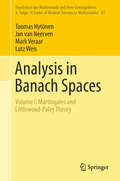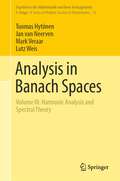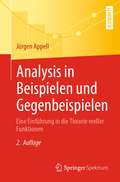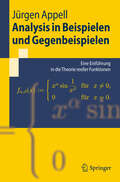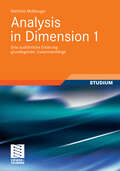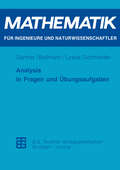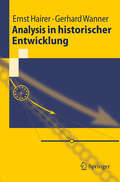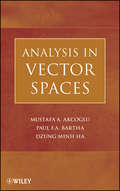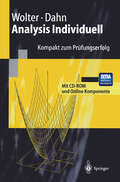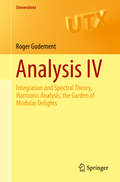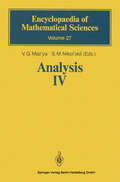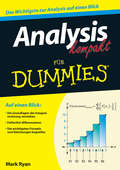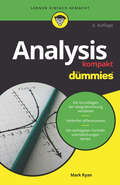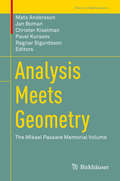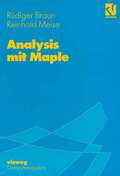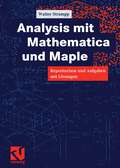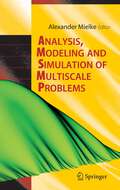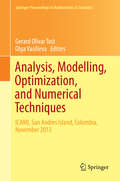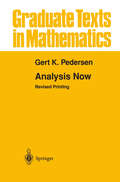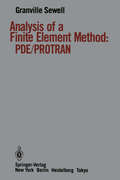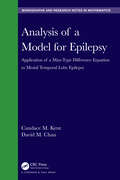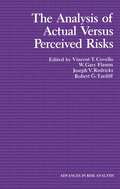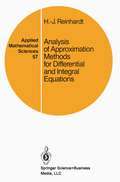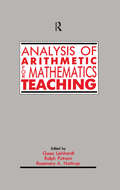- Table View
- List View
Analysis in Banach Spaces: Volume I: Martingales and Littlewood-Paley Theory (Ergebnisse der Mathematik und ihrer Grenzgebiete. 3. Folge / A Series of Modern Surveys in Mathematics #63)
by Tuomas Hytönen Jan van Neerven Mark Veraar Lutz WeisThe present volume develops the theory of integration in Banach spaces, martingales and UMD spaces, and culminates in a treatment of the Hilbert transform, Littlewood-Paley theory and the vector-valued Mihlin multiplier theorem. Over the past fifteen years, motivated by regularity problems in evolution equations, there has been tremendous progress in the analysis of Banach space-valued functions and processes. The contents of this extensive and powerful toolbox have been mostly scattered around in research papers and lecture notes. Collecting this diverse body of material into a unified and accessible presentation fills a gap in the existing literature. The principal audience that we have in mind consists of researchers who need and use Analysis in Banach Spaces as a tool for studying problems in partial differential equations, harmonic analysis, and stochastic analysis. Self-contained and offering complete proofs, this work is accessible to graduate students and researchers with a background in functional analysis or related areas.
Analysis in Banach Spaces: Volume III: Harmonic Analysis and Spectral Theory (Ergebnisse der Mathematik und ihrer Grenzgebiete. 3. Folge / A Series of Modern Surveys in Mathematics #76)
by Tuomas Hytönen Jan van Neerven Mark Veraar Lutz WeisThis third volume of Analysis in Banach Spaces offers a systematic treatment of Banach space-valued singular integrals, Fourier transforms, and function spaces. It further develops and ramifies the theory of functional calculus from Volume II and describes applications of these new notions and tools to the problem of maximal regularity of evolution equations. The exposition provides a unified treatment of a large body of results, much of which has previously only been available in the form of research papers. Some of the more classical topics are presented in a novel way using modern techniques amenable to a vector-valued treatment. Thanks to its accessible style with complete and detailed proofs, this book will be an invaluable reference for researchers interested in functional analysis, harmonic analysis, and the operator-theoretic approach to deterministic and stochastic evolution equations.
Analysis in Beispielen und Gegenbeispielen: Eine Einführung in die Theorie reeller Funktionen
by Jürgen AppellDas Buch führt in die Theorie der reellen Funktionen einer und mehrerer Variablen ein. Im Vordergrund stehen weniger abstrakte Ergebnisse als vielmehr die zahlreichen Beispiele und Gegenbeispiele, anhand derer die Bedeutung mathematischer Sätze deutlich gemacht wird. Kapitel 1 – 3 sind den wesentlichen Ergebnissen über stetige, differenzierbare und integrierbare Funktionen gewidmet, Kapitel 4 geht mit „merkwürdigen" Teilmengen der reellen Achse etwas über den üblichen Stoff hinaus. Funktionen mehrerer Variablen werden in Kapitel 5 bzw. 6 behandelt.
Analysis in Beispielen und Gegenbeispielen: Eine Einführung in die Theorie reeller Funktionen (Springer-Lehrbuch)
by Jürgen AppellDas Buch führt in die Theorie der reellen Funktionen einer und mehrerer Variablen ein. Im Vordergrund stehen weniger abstrakte Ergebnisse als vielmehr die zahlreichen Beispiele und Gegenbeispiele, anhand derer die Bedeutung mathematischer Sätze deutlich gemacht wird. Kapitel 1 – 3 sind den wesentlichen Ergebnissen über stetige, differenzierbare und integrierbare Funktionen gewidmet, Kapitel 4 geht mit „merkwürdigen" Teilmengen der reellen Achse etwas über den üblichen Stoff hinaus. Funktionen mehrerer Variablen werden in Kapitel 5 bzw. 6 behandelt.
Analysis in Dimension 1: Eine ausführliche Erklärung grundlegender Zusammenhänge
by Matthias MoßburgerAnalysis in Fragen und Übungsaufgaben (Mathematik für Ingenieure und Naturwissenschaftler, Ökonomen und Landwirte)
by Karl-Heinz Gärtner Margitta Bellmann Werner Lyska Roland SchmiederAnalysis in historischer Entwicklung (Springer-Lehrbuch)
by Ernst Hairer Gerhard WannerDiese Einführung in die Analysis orientiert sich an der historischen Entwicklung: Die ersten zwei Kapitel schlagen den Bogen von historischen Berechnungsmethoden zu unendlichen Reihen, zur Differential- und Integralrechnung und zu Differentialgleichungen. Die Etablierung einer mathematisch stringenten Denkhaltung im 19. Jahrhundert für ein und mehrere Variablen ist Thema der darauffolgenden Kapitel. Viele Beispiele, Berechnungen und Bilder machen den Band zu einem Lesevergnügen – für Studierende, für Lehrer und für Wissenschaftler.
Analysis in Vector Spaces
by Mustafa A. Akcoglu Paul F. Bartha Dzung Minh HaA rigorous introduction to calculus in vector spaces The concepts and theorems of advanced calculus combined with related computational methods are essential to understanding nearly all areas of quantitative science. Analysis in Vector Spaces presents the central results of this classic subject through rigorous arguments, discussions, and examples. The book aims to cultivate not only knowledge of the major theoretical results, but also the geometric intuition needed for both mathematical problem-solving and modeling in the formal sciences. The authors begin with an outline of key concepts, terminology, and notation and also provide a basic introduction to set theory, the properties of real numbers, and a review of linear algebra. An elegant approach to eigenvector problems and the spectral theorem sets the stage for later results on volume and integration. Subsequent chapters present the major results of differential and integral calculus of several variables as well as the theory of manifolds. Additional topical coverage includes: Sets and functions Real numbers Vector functions Normed vector spaces First- and higher-order derivatives Diffeomorphisms and manifolds Multiple integrals Integration on manifolds Stokes' theorem Basic point set topology Numerous examples and exercises are provided in each chapter to reinforce new concepts and to illustrate how results can be applied to additional problems. Furthermore, proofs and examples are presented in a clear style that emphasizes the underlying intuitive ideas. Counterexamples are provided throughout the book to warn against possible mistakes, and extensive appendices outline the construction of real numbers, include a fundamental result about dimension, and present general results about determinants. Assuming only a fundamental understanding of linear algebra and single variable calculus, Analysis in Vector Spaces is an excellent book for a second course in analysis for mathematics, physics, computer science, and engineering majors at the undergraduate and graduate levels. It also serves as a valuable reference for further study in any discipline that requires a firm understanding of mathematical techniques and concepts.
Analysis Individuell: Kompakt zum Prüfungserfolg
by Helmut Wolter Bernd I. DahnEin Lehrbuch - drei Komponenten! Die gedruckte Version bietet ein bisher einzigartiges Repetitorium zur Grundvorlesung Analysis. Es umfaßt in strukturierter und sich auf das Wesentliche beschränkende Form den Stoff, das Basiswissen für Vordiplom und Zwischenprüfungen Die beigefügte CD-ROM enthält das vollständige Lehrbuch mit ausführlichen Beweisen und Detailwissen, welches das Repetitorium ergänzt. Mit der auf der CD-ROM ebenfalls enthaltenen Zugangsberechtigung kann via Internet das auf einem Server liegende Buch nach individuellen Wissensbedürfnissen konfiguriert werden. Diese ideal auf die Kundenbedürfnisse abgestimmte Strategie zwischen Print, Off-line und On-line Version ist weltweit einzigartig.
Analysis IV: Integration and Spectral Theory, Harmonic Analysis, the Garden of Modular Delights (Universitext)
by Roger GodementAnalysis Volume IV introduces the reader to functional analysis (integration, Hilbert spaces, harmonic analysis in group theory) and to the methods of the theory of modular functions (theta and L series, elliptic functions, use of the Lie algebra of SL2). As in volumes I to III, the inimitable style of the author is recognizable here too, not only because of his refusal to write in the compact style used nowadays in many textbooks. The first part (Integration), a wise combination of mathematics said to be `modern' and `classical', is universally useful whereas the second part leads the reader towards a very active and specialized field of research, with possibly broad generalizations.
Analysis IV: Linear and Boundary Integral Equations (Encyclopaedia of Mathematical Sciences #27)
by V.G. Maz'yaA linear integral equation is an equation of the form XEX. (1) 2a(x)cp(x) - Ix k(x, y)cp(y)dv(y) = f(x), Here (X, v) is a measure space with a-finite measure v, 2 is a complex parameter, and a, k, f are given (complex-valued) functions, which are referred to as the coefficient, the kernel, and the free term (or the right-hand side) of equation (1), respectively. The problem consists in determining the parameter 2 and the unknown function cp such that equation (1) is satisfied for almost all x E X (or even for all x E X if, for instance, the integral is understood in the sense of Riemann). In the case f = 0, the equation (1) is called homogeneous, otherwise it is called inhomogeneous. If a and k are matrix functions and, accordingly, cp and f are vector-valued functions, then (1) is referred to as a system of integral equations. Integral equations of the form (1) arise in connection with many boundary value and eigenvalue problems of mathematical physics. Three types of linear integral equations are distinguished: If 2 = 0, then (1) is called an equation of the first kind; if 2a(x) i= 0 for all x E X, then (1) is termed an equation of the second kind; and finally, if a vanishes on some subset of X but 2 i= 0, then (1) is said to be of the third kind.
Analysis kompakt fur Dummies (Für Dummies)
by Mark RyanAn der Analysis kommen Sie nicht vorbei: Sei es nun in der Schule oder wenn Sie Natur-, Ingenieurs-, oder Wirtschaftswissenschaften studieren. Dieses Buch hilft Ihnen, wenn Sie sich einen schnellen Überblick über das Thema verschaffen wollen. Mark Ryan erklärt Ihnen leicht verständlich, was Sie über Grenzwerte und Funktionen unbedingt wissen sollten. So ist dies Ihr perfekter Nachhilfelehrer für die Tasche: freundlich, kompetent, günstig.
Analysis kompakt für Dummies (Für Dummies)
by Mark RyanAn der Analysis kommen Sie nicht vorbei: Sei es nun in der Schule oder wenn Sie Natur-, Ingenieurs- oder Wirtschaftswissenschaften studieren. Dieses Buch hilft Ihnen, wenn Sie sich einen schnellen Überblick über das Thema verschaffen wollen. Mark Ryan erklärt Ihnen leicht verständlich, was Sie über Grenzwerte, Ableitungen und Integrale unbedingt wissen sollten. Übungsaufgaben helfen Ihnen dabei, das Gelernte zu verinnerlichen. So ist dies Ihr perfekter Nachhilfelehrer für die Tasche: freundlich, kompetent, günstig.
Analysis Meets Geometry: The Mikael Passare Memorial Volume (Trends in Mathematics)
by Mats Andersson Jan Boman Christer Kiselman Pavel Kurasov Ragnar SigurdssonThis book is dedicated to the memory of Mikael Passare, an outstanding Swedish mathematician who devoted his life to developing the theory of analytic functions in several complex variables and exploring geometric ideas first-hand. It includes several papers describing Mikael’s life as well as his contributions to mathematics, written by friends of Mikael’s who share his attitude and passion for science. A major section of the book presents original research articles that further develop Mikael’s ideas and which were written by his former students and co-authors. All these mathematicians work at the interface of analysis and geometry, and Mikael’s impact on their research cannot be underestimated. Most of the contributors were invited speakers at the conference organized at Stockholm University in his honor. This book is an attempt to express our gratitude towards this great mathematician, who left us full of energy and new creative mathematical ideas.
Analysis mit Maple
by Rüdiger Braun Reinhold MeiseDer Aufbau des Buches orientiert sich an dem Standardwerk zur Analysis 1 und 2 von O. Forster.
Analysis, Modeling and Simulation of Multiscale Problems
by Alexander MielkeThis book reports recent mathematical developments in the Programme "Analysis, Modeling and Simulation of Multiscale Problems", which started as a German research initiative in 2006. Multiscale problems occur in many fields of science, such as microstructures in materials, sharp-interface models, many-particle systems and motions on different spatial and temporal scales in quantum mechanics or in molecular dynamics. The book presents current mathematical foundations of modeling, and proposes efficient numerical treatment.
Analysis, Modelling, Optimization, and Numerical Techniques: ICAMI, San Andres Island, Colombia, November 2013 (Springer Proceedings in Mathematics & Statistics #121)
by Gerard Olivar Tost Olga VasilievaThis book highlights recent compelling research results and trends in various aspects of contemporary mathematics, emphasizing applicabilitions to real-world situations. The chapters present exciting new findings and developments in situations where mathematical rigor is combined with common sense. A multi-disciplinary approach, both within each chapter and in the volume as a whole, leads to practical insights that may result in a more synthetic understanding of specific global issues as well as their possible solutions. The volume will be of interest not only to experts in mathematics, but also to graduate students, scientists, and practitioners from other fields including physics, biology, geology, management, and medicine.
Analysis Now (Graduate Texts in Mathematics #118)
by Gert K. PedersenGraduate students in mathematics, who want to travel light, will find this book invaluable; impatient young researchers in other fields will enjoy it as an instant reference to the highlights of modern analysis. Starting with general topology, it moves on to normed and seminormed linear spaces. From there it gives an introduction to the general theory of operators on Hilbert space, followed by a detailed exposition of the various forms the spectral theorem may take; from Gelfand theory, via spectral measures, to maximal commutative von Neumann algebras. The book concludes with two supplementary chapters: a concise account of unbounded operators and their spectral theory, and a complete course in measure and integration theory from an advanced point of view.
Analysis of a Finite Element Method: PDE/PROTRAN
by Granville SewellThis text can be used for two quite different purposes. It can be used as a reference book for the PDElPROTRAN user· who wishes to know more about the methods employed by PDE/PROTRAN Edition 1 (or its predecessor, TWODEPEP) in solving two-dimensional partial differential equations. However, because PDE/PROTRAN solves such a wide class of problems, an outline of the algorithms contained in PDElPROTRAN is also quite suitable as a text for an introductory graduate level finite element course. Algorithms which solve elliptic, parabolic, hyperbolic, and eigenvalue partial differential equation problems are pre sented, as are techniques appropriate for treatment of singularities, curved boundaries, nonsymmetric and nonlinear problems, and systems of PDEs. Direct and iterative linear equation solvers are studied. Although the text emphasizes those algorithms which are actually implemented in PDEI PROTRAN, and does not discuss in detail one- and three-dimensional problems, or collocation and least squares finite element methods, for example, many of the most commonly used techniques are studied in detail. Algorithms applicable to general problems are naturally emphasized, and not special purpose algorithms which may be more efficient for specialized problems, such as Laplace's equation. It can be argued, however, that the student will better understand the finite element method after seeing the details of one successful implementation than after seeing a broad overview of the many types of elements, linear equation solvers, and other options in existence.
Analysis of a Model for Epilepsy: Application of a Max-Type Difference Equation to Mesial Temporal Lobe Epilepsy (Chapman & Hall/CRC Monographs and Research Notes in Mathematics)
by Candace M. Kent David M. ChanIn the 1960s and 1970s, mathematical biologists Sir Robert M. May, E.C. Pielou, and others utilized difference equations as models of ecological and epidemiological phenomena. Since then, with or without applications, the mathematics of difference equations has evolved into a field unto itself. Difference equations with the maximum (or the minimum or the "rank-type") function were rigorously investigated from the mid-1990s into the 2000s, without any applications in mind. These equations often involved arguments varying from reciprocal terms with parameters in the numerators to other special functions. Recently, the authors of Analysis of a Model for Epilepsy: Application of a Max-Type Difference Equation to Mesial Temporal Lobe Epilepsy and their colleagues investigated the first known application of a "max-type" difference equation. Their equation is a phenomenological model of epileptic seizures. In this book, the authors expand on that research and present a more comprehensive development of mathematical, numerical, and biological results. Additionally, they describe the first documented instance of a novel dynamical behavior that they call rippled almost periodic behavior, which can be described as an unpredictable pseudo-periodic behavior. Features: Suitable for researchers in mathematical neuroscience and potentially as supplementary reading for postgraduate students Thoroughly researched and replete with references
Analysis of a Model for Epilepsy: Application of a Max-Type Difference Equation to Mesial Temporal Lobe Epilepsy (Chapman & Hall/CRC Monographs and Research Notes in Mathematics)
by Candace M. Kent David M. ChanIn the 1960s and 1970s, mathematical biologists Sir Robert M. May, E.C. Pielou, and others utilized difference equations as models of ecological and epidemiological phenomena. Since then, with or without applications, the mathematics of difference equations has evolved into a field unto itself. Difference equations with the maximum (or the minimum or the "rank-type") function were rigorously investigated from the mid-1990s into the 2000s, without any applications in mind. These equations often involved arguments varying from reciprocal terms with parameters in the numerators to other special functions. Recently, the authors of Analysis of a Model for Epilepsy: Application of a Max-Type Difference Equation to Mesial Temporal Lobe Epilepsy and their colleagues investigated the first known application of a "max-type" difference equation. Their equation is a phenomenological model of epileptic seizures. In this book, the authors expand on that research and present a more comprehensive development of mathematical, numerical, and biological results. Additionally, they describe the first documented instance of a novel dynamical behavior that they call rippled almost periodic behavior, which can be described as an unpredictable pseudo-periodic behavior. Features: Suitable for researchers in mathematical neuroscience and potentially as supplementary reading for postgraduate students Thoroughly researched and replete with references
The Analysis of Actual Versus Perceived Risks (Advances in Risk Analysis #1)
by V. T. Covello W. Gary Flamm Joseph V. Rodricks Robert G. TardiffIn 1980, a group of scientists from national laboratories, universities, and other research organizations gathered informally in a series of meetings to consider the state of research on risks to health, safety, and the environment. Each scientist had conducted research on the subject. All felt that the traditional disciplines and professional societies to which they belonged were neither ade quate nor appropriate for addressing the extraordinarily complex problems of assessing the risks inherent in modern society. The con sensus of the group was that a new society was needed to address these problems in a scientific and objective way. From these initial meetings, the Society for Risk Analysis was formed The major aims of the Society for Risk Analysis, as stated in its constitution, are • to promote knowledge and understanding of risk analysis techniques and their applications; • to promote communication and interaction among those engaged in risk analysis; and • to disseminate risk analysis information and promote the advancement of all aspects of risk analysis. Members of the Society are drawn from a variety of disciplines, including the health sciences, engineering, the physical sciences, the humanities, and the behavioral and social sciences. An import ant function of the Society is the annual meeting, at which var ious aspects of risk analysis are discussed. The first annual meet ing, represented by this volume, was the International Workshop on the Analysis of Actual vs.
Analysis of Approximation Methods for Differential and Integral Equations (Applied Mathematical Sciences #57)
by Hans-Jürgen ReinhardtThis book is primarily based on the research done by the Numerical Analysis Group at the Goethe-Universitat in Frankfurt/Main, and on material presented in several graduate courses by the author between 1977 and 1981. It is hoped that the text will be useful for graduate students and for scientists interested in studying a fundamental theoretical analysis of numerical methods along with its application to the most diverse classes of differential and integral equations. The text treats numerous methods for approximating solutions of three classes of problems: (elliptic) boundary-value problems, (hyperbolic and parabolic) initial value problems in partial differential equations, and integral equations of the second kind. The aim is to develop a unifying convergence theory, and thereby prove the convergence of, as well as provide error estimates for, the approximations generated by specific numerical methods. The schemes for numerically solving boundary-value problems are additionally divided into the two categories of finite difference methods and of projection methods for approximating their variational formulations.
Analysis of Arithmetic for Mathematics Teaching
by Gaea LeinhardtThis volume emerges from a partnership between the American Federation of Teachers and the Learning Research and Development Center at the University of Pittsburgh. The partnership brought together researchers and expert teachers for intensive dialogue sessions focusing on what each community knows about effective mathematical learning and instruction. The chapters deal with the research on, and conceptual analysis of, specific arithmetic topics (addition, subtraction, multiplication, division, decimals, and fractions) or with overarching themes that pervade the early curriculum and constitute the links with the more advanced topics of mathematics (intuition, number sense, and estimation). Serving as a link between the communities of cognitive researchers and mathematics educators, the book capitalizes on the recent research successes of cognitive science and reviews the literature of the math education community as well.
